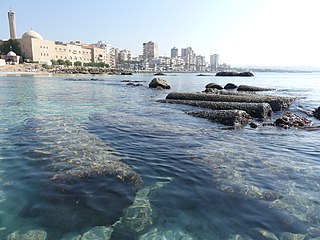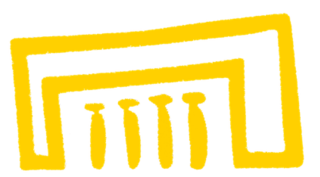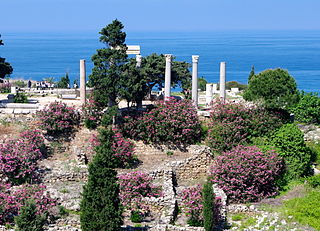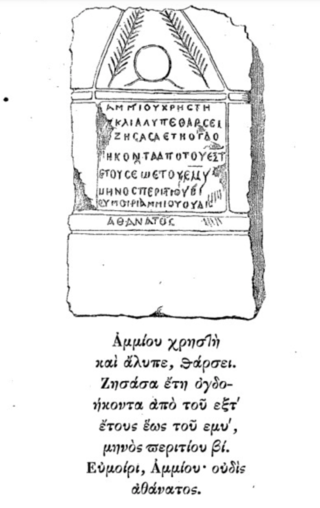
Tyre is a city in Lebanon, one of the oldest continually inhabited cities in the world, though in medieval times for some centuries by just a tiny population. It was one of the earliest Phoenician metropolises and the legendary birthplace of Europa, her brothers Cadmus and Phoenix, as well as Carthage's founder Dido (Elissa). The city has many ancient sites, including the Tyre Hippodrome, and was added as a whole to UNESCO's list of World Heritage Sites in 1984. The historian Ernest Renan noted that "One can call Tyre a city of ruins, built out of ruins".

Byblos, also known as Jebeil, Jbeil or Jubayl, is a city in the Keserwan-Jbeil Governorate of Lebanon. It is believed to have been first occupied between 8800 and 7000 BC and continuously inhabited since 5000 BC, making it one of the oldest continuously inhabited cities in the world. During its history, Byblos was part of numerous civilisations, including Egyptian, Phoenician, Assyrian, Persian, Hellenistic, Roman, Fatimid, Genoese, Mamluk and Ottoman. The city is a UNESCO World Heritage Site.

The sarcophagus ofEshmunazar II is a 6th-century BC sarcophagus unearthed in 1855 in the grounds of an ancient necropolis southeast of the city of Sidon, in modern-day Lebanon, that contained the body of Eshmunazar II, Phoenician King of Sidon. One of only three Ancient Egyptian sarcophagi found outside Egypt, with the other two belonging to Eshmunazar's parents King Tabnit and Queen Amoashtart, it was likely carved in Egypt from local amphibolite, and captured as booty by the Sidonians during their participation in Cambyses II's conquest of Egypt in 525 BC. The sarcophagus has two sets of Phoenician inscriptions, one on its lid and a partial copy of it on the sarcophagus trough, around the curvature of the head. The lid inscription was of great significance upon its discovery as it was the first Phoenician language inscription to be discovered in Phoenicia proper and the most detailed Phoenician text ever found anywhere up to that point, and is today the second longest extant Phoenician inscription, after the Karatepe bilingual.

Maghdouché is a town in the South Governorate of Lebanon. It is located 50 km south of Beirut and 8 km southeast of Sidon. The village lies 3 km inland from the Mediterranean, occupying a hill with elevation ranging between 200 and 229 meters above sea level.

The National Museum of Beirut is the principal museum of archaeology in Lebanon. The collection begun after World War I, and the museum was officially opened in 1942. The museum has collections totaling about 100,000 objects, most of which are antiquities and medieval finds from excavations undertaken by the Directorate General of Antiquities.

The Mission de Phénicie was the first major archaeological mission to Lebanon and Syria. It took place in 1860-61 by a French team led by Ernest Renan. Renan was entrusted with the mission in October 1860, after French interest had been sparked by the 1855 discovery of the Sarcophagus of Eshmunazar II.

The Temple of Eshmun is an ancient place of worship dedicated to Eshmun, the Phoenician god of healing. It is located near the Awali river, 2 kilometres (1.2 mi) northeast of Sidon in southwestern Lebanon. The site was occupied from the 7th century BC to the 8th century AD, suggesting an integrated relationship with the nearby city of Sidon. Although originally constructed by Sidonian king Eshmunazar II in the Achaemenid era to celebrate the city's recovered wealth and stature, the temple complex was greatly expanded by Bodashtart, Yatonmilk and later monarchs. Because the continued expansion spanned many centuries of alternating independence and foreign hegemony, the sanctuary features a wealth of different architectural and decorative styles and influences.

Amrit, the classical Marathus, was a Phoenician port located near present-day Tartus in Syria. Founded in the third millennium BC, Marat was the northernmost important city of ancient Phoenicia and a rival of nearby Arwad. During the 2nd century BC, Amrit was defeated and its site largely abandoned, leaving its ruins well preserved and without extensive remodeling by later generations.

The Byblian royal inscriptions are five inscriptions from Byblos written in an early type of Phoenician script, all of which were discovered in the early 20th century.

The Roman temple of Bziza is a well-preserved first century AD building dedicated to Azizos, a personification of the morning star in the Canaanite mythology. This Roman temple lends the modern Lebanese town of Bziza its current name, as Bziza is a corruption of Beth Azizo meaning the house or temple of Azizos. Azizos was identified as Ares by Emperor Julian.

Umm Al Amad, or Umm el 'Amed or al Auamid or el-Awamid, is an Hellenistic period archaeological site near the town of Naqoura in Lebanon. It was discovered by Europeans in the 1770s, and was excavated in 1861. It is one of the most excavated archaeological sites in the Phoenician heartland.
The Baal Lebanon inscription, known as KAI 31, is a Phoenician inscription found in Limassol, Cyprus in eight bronze fragments in the 1870s. At the time of their discovery, they were considered to be the second most important finds in Semitic palaeography after the Mesha stele.
The Thrones of Astarte are approximately a dozen ex-voto "cherubim" thrones found in ancient Phoenician temples in Lebanon, in particular in areas around Sidon, Tyre and Umm al-Amad. Many of the thrones have a similar style, with cherubim heads on winged lion bodies on either side. Images of the thrones are found in Phoenician sites around the Mediterranean, including an ivory plaque from Tel Megiddo (Israel), a relief from Hadrumetum (Tunisia) and a scarab from Tharros (Italy).

The Yehawmilk stele, de Clercq stele, or Byblos stele, also known as KAI 10 and CIS I 1, is a Phoenician inscription from c.450 BC found in Byblos at the end of Ernest Renan's Mission de Phénicie. Yehawmilk, king of Byblos, dedicated the stele to the city’s protective goddess Ba'alat Gebal.

The royal necropolis of Byblos is a group of nine Bronze Age underground shaft and chamber tombs housing the sarcophagi of several kings of the city. Byblos is a coastal city in Lebanon, and one of the oldest continuously populated cities in the world. The city established major trade links with Egypt during the Bronze Age, resulting in a heavy Egyptian influence on local culture and funerary practices. The location of ancient Byblos was lost to history, but was rediscovered in the late 19th century by the French biblical scholar and Orientalist Ernest Renan. The remains of the ancient city sat on top of a hill in the immediate vicinity of the modern city of Jbeil. Exploratory trenches and minor digs were undertaken by the French mandate authorities, during which reliefs inscribed with Egyptian hieroglyphs were excavated. The discovery stirred the interest of western scholars, leading to systematic surveys of the site.

Deir Ez Zahrani is a populated area in southern Lebanon. It is located 75 kilometres (47 mi) from Beirut.

The Umm Al-Amad votive inscription is an ex-voto Phoenician inscription of two lines. Discovered during Ernest Renan's Mission de Phénicie in 1860–61, it was the second-longest of the three inscriptions found at Umm al-Amad. All three inscriptions were found on the north side of the hill.

The Baalshamem inscription is a Phoenician inscription discovered in 1860–61 at Umm al-Amad, Lebanon, the longest of three inscriptions found there during Ernest Renan's Mission de Phénicie. All three inscriptions were found on the north side of the hill; this inscription was found in the foundation of one of the ruined houses covering the hill.
Carne or Carnos was an ancient Phoenician city opposite to the island-city Arados, north of Tartus. Carne was the port of Arados on the mainland, the only port city of its dependencies.

The Phoenician sanctuary of Kharayeb is a historic temple in the town of Kharayeb, situated in the hinterland of Tyre in Southern Lebanon. It was surveyed during three archaeological missions. The first mission, led by then Director of Lebanon's Antiquities Maurice Chehab in 1946, revealed a Hellenistic period temple and thousands of clay figurines dating from the sixth to the first centuries BC. Subsequent excavations in 1969, carried out by Lebanese archaeologist Brahim Kaoukabani, and a more recent survey in 2009, funded by the Italian government, yielded significant discoveries regarding cultic practices and a detailed reconstruction of the sanctuary's architecture and development.





















